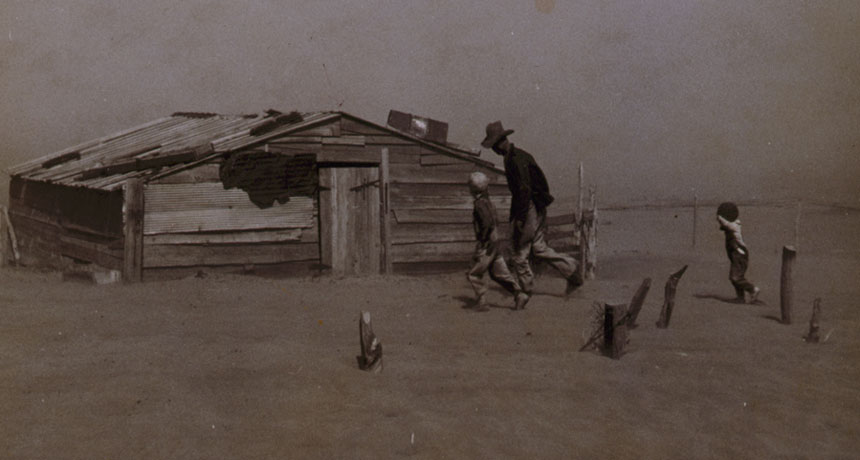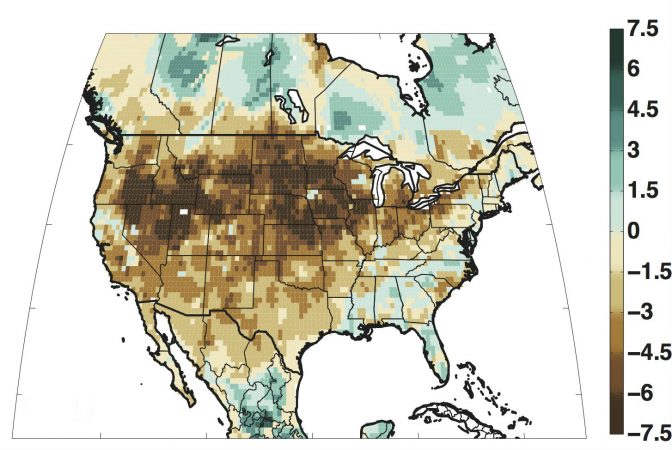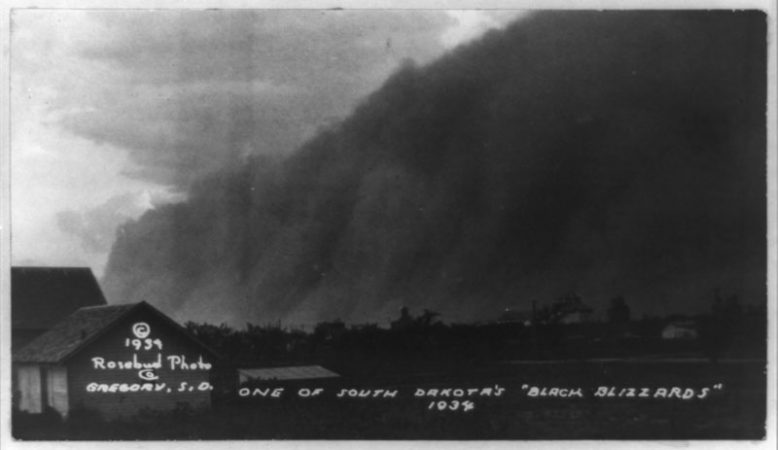The worst drought in 1,000 years
New records show no year was drier across North America than 1934

This 1936 photo shows a farmer and his two sons during a dust storm in Cimarron County, Okla. The drought that struck North America two years earlier was the driest and most widespread in 1,000 years, a new study finds. It was just one of four major droughts between 1930 and 1940, a period called the Dust Bowl.
Arthur Rothstein, Farm Security Administration
By Beth Geiger
In the 2014 movie “Interstellar,” drought, dust storms and failed crops drive humans from Earth. It’s science fiction, of course, but the premise is grounded in history. Throughout the 1930s, horrible drought and dust storms really did devastate large areas of the United States. As in the movie, these conditions drove many farmers and their families to flee in hunger and despair.
The four major droughts to strike during that decade led to its being called the Dust Bowl. This devastating dry spell ravaged the Great Plains states of Texas, Oklahoma, Colorado and Kansas, along with most other western states. By nearly all accounts, the most terrible year of all was 1934. Some accounts have reported that by that year, one county in Oklahoma didn’t have a single blade of grass or wheat left.

“The 1930s drought was previously regarded as a really bad drought,” says lead author Benjamin Cook. He’s a climate scientist with NASA’s Goddard Institute for Space Studies in New York City. “Our latest study, though, was able to show that 1934 was not only bad, but was probably worse than any other single drought year to occur in the last 1,000 years,” Cook tells Science News For Students. In fact, 1934 was 30 percent worse than the next driest year in North America. That was 1580.
The authors used historical records as well as records of annual growth rings from both dead and living trees from across North America. The study of tree rings is called dendrochronology. Each annual growth ring in a tree gives clues to that year’s environmental conditions, including how much precipitation fell.
Cook explains that his team studied tree-ring data that had been matched to a scale called the Palmer Drought Severity Index. “Narrow rings translate into negative values of the index, indicating drought,” Cook explains. “Wide rings translate into positive values of the index, indicating wetter-than-normal years.” The new study is the first to look in detail at a specific year during the Dust Bowl. Cook’s team published the details October 18 in Geophysical Research Letters.
Black blizzards
The extreme drought and its effects were the result of a one-two punch, the study finds. First, during the winter of early 1934, a ridge of high-pressure air settled over California. That ridge, says Cook, diverted storms far to the north. Come spring, that high-pressure area moved east, blocking rain from the Great Plains as well.

These dust storms not only blackened the air, but actually kept rain from falling, says Cook. During the spring and summer, the Great Plains usually get moisture from thunderstorms, which are driven by solar energy absorbed by the ground. The effect causes moisture to rise and form clouds. But dust particles have a high albedo, he notes. That means they are very good at reflecting sunlight. “So, when there are lots of dust particles in the atmosphere,” he says, “less energy is reaching and heating the surface.” Back in the Dust Bowl era, that prevented thunderstorms from developing.
Later, the U.S. government helped farmers find better ways to work the land so that soil erosion was minimized. Still, there will be other droughts. “The year 1934 should serve as a reminder that we must take our climate seriously, and not ignore possible changes to come,” says Jonathan Overpeck. A climate scientist, he works at the University of Arizona in Tucson. He notes that “It was devastating then. And it would be again if such a drought were to reoccur.”
Power words
albedo The percentage of radiation falling upon an object that is reflected. In astronomical terms, albedo is the percentage of sunlight that an object bounces back into space
dendrochronology The study of annual growth rings from trees, used to evaluate environmental conditions affecting the tree over time.
drought An extended period of abnormally low rainfall; a shortage of water resulting from this.
dust storm A moving, blowing cloud of dust carried by the wind.
erode Removal of soil or stone, caused by the flow of water or the movement of winds.
NASA (National Aeronautics and Space Administration) Created in 1958, this U.S. agency has become a leader in space research and in stimulating public interest in space exploration. It was through NASA that the United States sent people into orbit and ultimately to the moon. It has also sent research craft to study planets and other celestial objects in our solar system.







